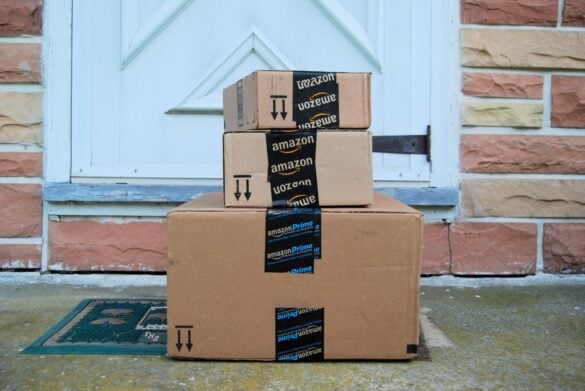Amazon was responsible for 45% of all e-commerce spending in the United States in 2019.
In fact, even if they don’t buy from Amazon, many shoppers begin their search on Amazon. Naturally, this makes Amazon one of the most important platforms for retailers worldwide.
But with lots of customers comes lots of competition. Although you can create an Amazon account and begin listing products within minutes, it takes an effective marketing strategy to start bringing in customers — which is much easier said than done.
In this guide, we’ll tell you everything you need to know about Amazon marketing so you can start building an effective strategy to stand out from the crowd.
What is Amazon Marketing?
Amazon marketing is the term that covers a variety of factors that combine to help sellers promote their products, boost brand awareness, and ultimately increase sales within the Amazon platform.
There isn’t a single digital marketing strategy that defines being successful on Amazon. Tactics range from organic growth methods to paid advertising to SEO marketing.
When classifying Amazon marketing, it can be broken up into two groups: internal and external marketing. Internal marketing refers to strategies used within the Amazon platform. External marketing refers to tactics outside the platform, like advertising your brand on other social media platforms such as Facebook, YouTube, Twitter, Google, etc.
This article will cover different strategies related to Amazon’s internal marketing.

Amazon Marketing Services
73% of Amazon sellers buy ads on Amazon’s built-in advertising platform. They do this to boost visibility and drive brand awareness through its perfect positioning on the platform.
While there are several cost-free organic marketing methods for Amazon (which we’ll get to later), an effective Amazon marketing strategy usually starts by utilizing Amazon Marketing Services (AMS).
Amazon Marketing Services (otherwise known as Amazon Advertising Console) is like the “Google Ads of Amazon.” It uses a pay-per-click (PPC) methodology for both sellers on Amazon and sellers off the platform.
There are four different types of ads that AMS offers:
1. Sponsored Display Ads
These are the advertisements that are shown to audiences that have shown an interest in the type of product that you’re selling.
For example, a customer that viewed your product but didn’t make a purchase might see one of these ads. Another person who looked in a similar category to your products can also be shown a Sponsored Product Display Ad.
2. Sponsored Products Ads
These ads let sellers promote a specific product. When a customer clicks on the ad, it sends them directly to the product listing page. Amazon boasts that these ads usually receive more than 54% more views and 40% more sales than products that aren’t promoted.
3. Sponsored Brands Ads
These are similar to Sponsored Products Ads, but instead of promoting a specific product, they promote their brand in a custom headline. These will direct customers to their store page or the product page.
4. Amazon Stores
Amazon Stores is quite different than the other ads but still falls under the AMS category. This allows retailers to build their own landing page that a sponsored ad directs to.
Amazon Advertising Best Practices
No matter which AMS avenue you take, it’s essential to create and manage ads strategically. You can’t just buy ads and expect them to bring in tons of customers.
Let’s take a look at some best practices to boost your marketing efforts when it comes to running AMS ads.
Targeting
When using Sponsored Display Ads or Sponsored Products Ads, it is vital to utilize product targeting effectively.
This means that your ads are only shown to the right people in the best situations. Amazon offers targeting options such as interest, views, and product-based.
If done correctly, your product will only be shown to people who have shown an interest in similar product categories or have purchased similar products before.

Bidding
When first using AMS services, people tend to set their PPC bids relatively high. Although these can result in higher visibility, they can also raise your Advertising Cost of Sale (ACoS).
You don’t want to spend more on advertising than you’re earning through sales. Finding the perfect balance takes time. Learn to master Amazon’s built-in Dynamic Bidding tool to find the ideal bid for a place for your ads.
Ad Creative
The creative elements of your ads are vital to a successful advertising campaign. According to Amazon’s own research, creating concise messaging in your ad can boost the clickthrough rate by 74%.
Keep your ads simple, as this has shown to raise the clickthrough rate as well. And always add a call-to-action to persuade shoppers to click and move to your product page.
Testing
One of the most important aspects of any marketing campaign is testing and refining your marketing strategies. There is always room for improvement to make your ads more effective.
Amazon offers an A/B testing tool that allows you to compare the performance of different versions of your ads.
Use this tool and change elements to see what works better. Some things you can change include:
- Title
- Product Description
- Price
- Ad creative
- Call-to-action
- Bullet points
The opportunities are endless. Keep testing to find the best ad that drives more customers to your store.
Organic Amazon SEO
Amazon Marketing Services offers great paid advertising strategies, but you can also take advantage of several organic digital marketing techniques.
Amazon search engine optimization (SEO) is another crucial component of an effective marketing strategy.
SEO refers to the practice of reaching the top results of search engines like Google. Several factors affect their ranking, including:
- Quality information
- High-quality images
- Accurate keywords/search terms
- Good domain authority
- Optimized content
Reaching the top of the rankings can result in vast amounts of organic traffic to their website. This same strategy can be applied to Amazon and its search box.
Keyword Research
Just like Google, Amazon’s algorithm looks at your titles and descriptions to find relevant keywords (frontend keywords) and backend keywords that aren’t visible to customers.
To find the best keywords that can get you ranked, research thoroughly to find what works best for your products.

You can do this through Amazon by going through the Search Terms report. This will show you what Amazon customers are searching for in different categories. You can also use external tools like Google’s keyword planner.
Product Copy
Keywords aren’t the only important part of Amazon SEO. It also looks at the quality of your content. Make sure you optimize your product copy to create A-rated content.
Four categories create A-rated content:
- Optimized titles
- Optimized descriptions
- Optimized content length
- Optimized visuals
A-rated content ranks higher than any other content in Amazon SERPs (search engine results pages), which means more visibility and a higher clickthrough rate.
Product Images
Customers first see the image associated with your product, so it’s essential to ensure they look top-tier.
All products must have a “main image” in SERPs with a plain white background. After that, Amazon recommends including at least six images to optimize SEO in listings. This helps customers compare and evaluate products.
Ensure your images are clear, informative, and contain text when necessary. Using text in pictures adds another layer to your marketing where you can answer questions or add dimensions.
Reviews
Your review profile is another tool that digital marketers can use to boost rankings.
Obviously, positive reviews are a massive factor in building trust in customers and building customer loyalty. A new customer is much more likely to buy from a store with positive reviews than negative reviews.
But when it comes to SEO, reviews also show Amazon that users are engaging with your brand, which is an essential ranking factor in SEO.
Ask your customers to leave reviews. You can even join review programs like the Early Reviewer program or Amazon Vine.
Product Features and Details
Adding easy-to-read bullet points that contain as much information as possible about your product is a best practice among successful Amazon sellers.
Although this doesn’t directly affect Amazon SEO, it does affect conversion rate and product relevance. These can indirectly help improve rankings, leading to higher product visibility. This makes it another important factor for organic marketing.
Start Building Your Amazon Empire
Building your Amazon store can be daunting with so many different strategies and tools at your disposal. But if you take it one step at a time, you’ll quickly learn that Amazon marketing can be one of the most powerful tools for your online retailer.
If you’re looking for a top-tier digital marketing partner to help you capture your customers’ attention, contact us and get a free quote today!
